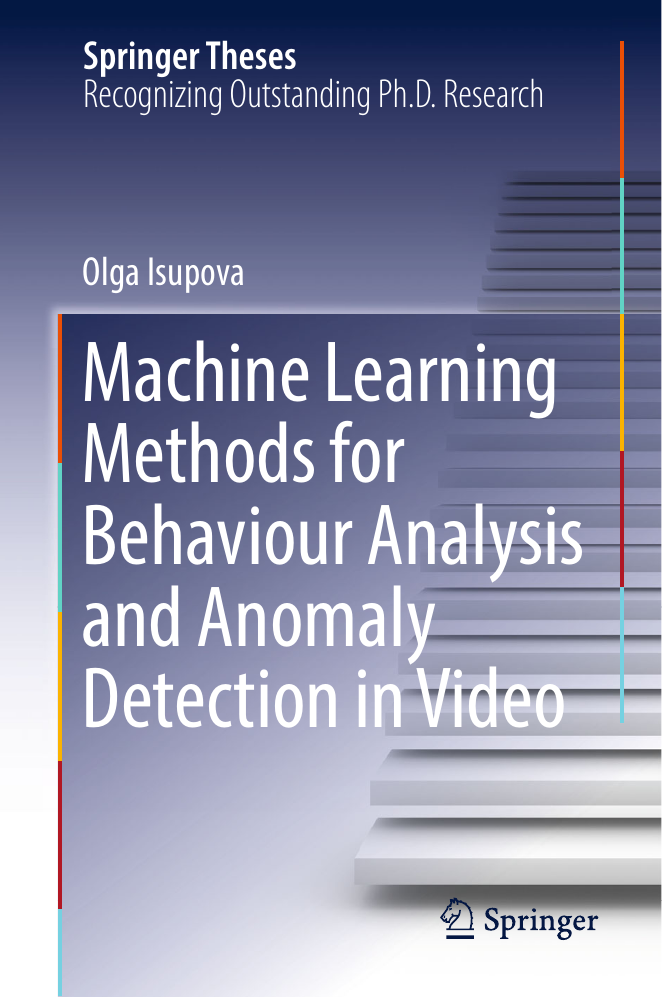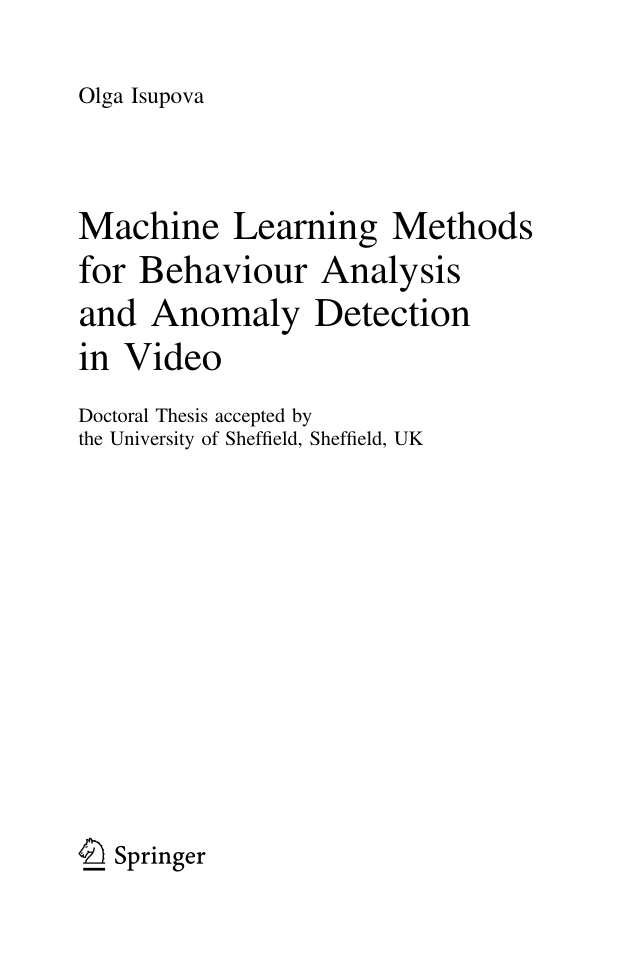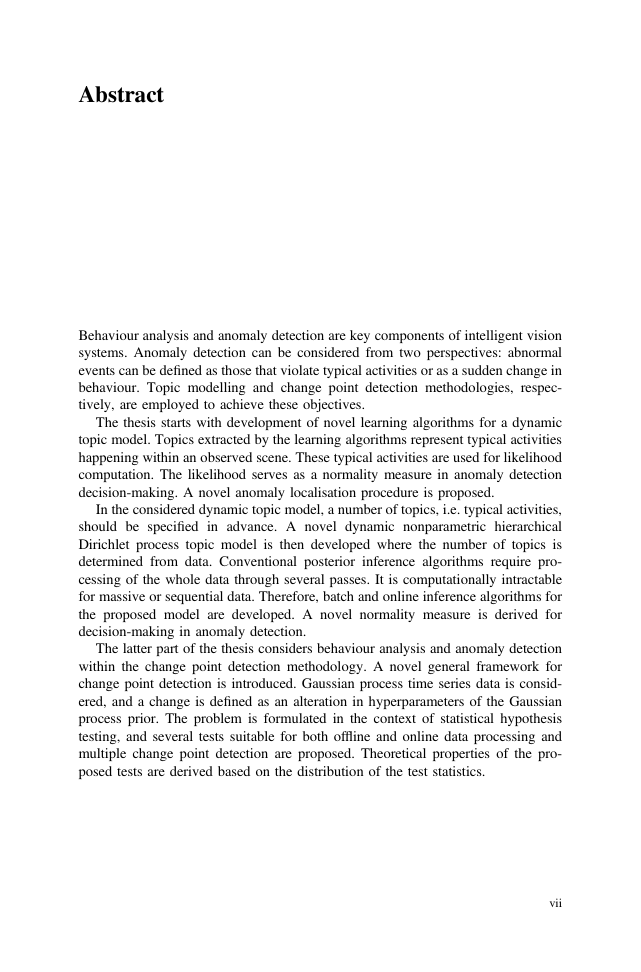Supervisor’s Foreword
Abstract
Acknowledgements
Contents
Acronyms
Notation
List of Figures
List of Tables
1 Introduction
1.1 Abnormal Behaviour Detection
1.1.1 Topic Modeling
1.1.2 Change Point Detection
1.2 Key Contributions and Outline
1.3 Disseminated Results
References
2 Background
2.1 Outline of Video Processing Methods
2.1.1 Object Detection
2.1.2 Object Tracking
2.2 Anomaly Detection
2.2.1 Video Representation
2.2.2 Behaviour Model
2.2.3 Normality Measure
2.3 Topic Modeling
2.3.1 Problem Formulation
2.3.2 Inference
2.3.3 Extensions of Conventional Models
2.3.4 Dynamic Topic Models
2.3.5 Topic Modeling Applied to Video Analytics
2.4 Change Point Detection
2.4.1 Change Point Detection in Time Series Data
2.4.2 Anomaly as Change Point Detection
2.5 Summary
References
3 Proposed Learning Algorithms for Markov Clustering Topic Model
3.1 Video Representation
3.2 Model
3.2.1 Motivation
3.2.2 Model Formulation
3.3 Parameter Learning
3.3.1 Expectation-Maximisation Learning
3.3.2 Variational Inference
3.3.3 Gibbs Sampling
3.3.4 Similarities and Differences of the Learning Algorithms
3.4 Anomaly Detection
3.4.1 Abnormal Documents Detection
3.4.2 Localisation of Anomalies
3.5 Performance Validation
3.5.1 Performance Measure
3.5.2 Parameter Learning
3.5.3 Anomaly Detection
3.6 Summary
References
4 Dynamic Hierarchical Dirichlet Process
4.1 Hierarchical Dirichlet Process Topic Model
4.1.1 Chinese Restaurant Franchise
4.2 Proposed Dynamic Hierarchical Dirichlet Process Topic Model
4.3 Inference
4.3.1 Batch Collapsed Gibbs Sampling
4.3.2 Online Inference
4.4 Anomaly Detection
4.5 Experiments
4.5.1 Synthetic Data
4.5.2 Real Video Data
4.6 Summary
References
5 Change Point Detection with Gaussian Processes
5.1 Problem Formulation
5.1.1 Data Model
5.1.2 Change Point Detection Problem Formulation
5.2 Gaussian Process Change Point Detection Approach Based on Likelihood Ratio Tests
5.2.1 Likelihood Ratio Test
5.2.2 Generalised Likelihood Ratio Test
5.2.3 Discussion
5.3 Gaussian Process Online Change Point Detection Approach Based on Likelihood Estimation
5.3.1 Test Formulation
5.3.2 Theoretical Evaluation of the Test
5.3.3 Test with Estimated Hyperparameters
5.3.4 Discussion
5.4 Performance Validation on Synthetic Data
5.4.1 Data Simulated by the Proposed Generative Model
5.4.2 Data Simulated by the GP-BOCPD Model
5.5 Numerical Experiments with Real Data
5.6 Summary
References
6 Conclusions and Future Work
6.1 Summary of Methods and Contributions
6.2 Suggestions for Future Work
6.2.1 Inference in Topic Modeling
6.2.2 Alternative Dynamics in Topic Modeling
6.2.3 Gaussian Process Change Point Detection
6.2.4 Potential Applications of the Proposed Statistical Methods
References
A EM for MCTM Derivation
Appendix B VB for MCTM Derivation
Appendix C Distributions of Quadratic Forms
C.1 Quadratic form of the ``Own'' Covariance Matrix
C.2 Quadratic form of an Arbitrary Symmetric Matrix
Appendix D Proofs of the Theorems for the Proposed Test Statistic
D.1 Proof of Theorem 5.1
D.2 Proof of Theorem 5.2
Appendix E Optimisation of Gaussian Process Covariance Function Hyperparameters
References
















 2023年江西萍乡中考道德与法治真题及答案.doc
2023年江西萍乡中考道德与法治真题及答案.doc 2012年重庆南川中考生物真题及答案.doc
2012年重庆南川中考生物真题及答案.doc 2013年江西师范大学地理学综合及文艺理论基础考研真题.doc
2013年江西师范大学地理学综合及文艺理论基础考研真题.doc 2020年四川甘孜小升初语文真题及答案I卷.doc
2020年四川甘孜小升初语文真题及答案I卷.doc 2020年注册岩土工程师专业基础考试真题及答案.doc
2020年注册岩土工程师专业基础考试真题及答案.doc 2023-2024学年福建省厦门市九年级上学期数学月考试题及答案.doc
2023-2024学年福建省厦门市九年级上学期数学月考试题及答案.doc 2021-2022学年辽宁省沈阳市大东区九年级上学期语文期末试题及答案.doc
2021-2022学年辽宁省沈阳市大东区九年级上学期语文期末试题及答案.doc 2022-2023学年北京东城区初三第一学期物理期末试卷及答案.doc
2022-2023学年北京东城区初三第一学期物理期末试卷及答案.doc 2018上半年江西教师资格初中地理学科知识与教学能力真题及答案.doc
2018上半年江西教师资格初中地理学科知识与教学能力真题及答案.doc 2012年河北国家公务员申论考试真题及答案-省级.doc
2012年河北国家公务员申论考试真题及答案-省级.doc 2020-2021学年江苏省扬州市江都区邵樊片九年级上学期数学第一次质量检测试题及答案.doc
2020-2021学年江苏省扬州市江都区邵樊片九年级上学期数学第一次质量检测试题及答案.doc 2022下半年黑龙江教师资格证中学综合素质真题及答案.doc
2022下半年黑龙江教师资格证中学综合素质真题及答案.doc